*NURSING > QUESTIONS & ANSWERS > USMLE World Step 3 questions and answers. 100% pass rate, graded A+ (All)
USMLE World Step 3 questions and answers. 100% pass rate, graded A+
Document Content and Description Below
USMLE World Step 3 questions and answers. 100% pass rate, graded A+ Acute scrotal pain - ✔✔1. pain predominant testicular torsion: medical emergency need surgical detorsion and orchiopexy(fi... xation of both testes) cremasteric reflex: positive if there is elevation of the testis in response to stroking the upper inner thigh It is negative in testicular torsion and boys < 6 months Negative cremasteric reflex and abnormal testicle lay are high suggestive of testicular torsion. Doppler U/S or nuclear scan of scrotum can help diagnosis of testicular torsion in the case of clinical uncertainity torsion of the appendix testis epididymitis: pain relief with scrotum elevation, not reliable for diagnosis, U/A is recommended for all suspected epididymitis, urethral swab is recommended for STD induced epididymitis 2. swelling predominant hydrocele: typically not painful positive translumination of scrotum, a cystic scrotal fluid collection between the parietal and visceral layers of the tunica vaginalis that can communicate, increased size during the day and with Valsalva maneuver varicocele spermatocele testicular cancer Varicocele - ✔✔Venous drainage of the testes involves a complex network of veins called the pampiniform plexus, which are responsible for keeping the temperature of the scrotal sacs below the normal body temperature. Seminiferous tubules make up most of the testicular mass, and are very sensitive to an ↑temperature .Dilation of the pampiniform plexus (varicocele) results in an ↑temperature of the scrotal sacs → testicular atrophy Androgen-secreting Leydig cells are more resistant to an↑ in temperature caused by varicoceles therefore impotence is not common in varicocele. Varicoceles are more common on the left side because the left spermatic vein enters the left renal vein at a 90-degree angle. The right spermatic vein drains at a more obtuse angle directly into the inferior vena cava, thereby facilitating a more continuous flow. Processes that cause IVC obstruction(clot, tumor) should be ruled out in patients who have bilateral varicocele, right varicocles or varicocele that does not disappear in the supine postion (abdominal CT) Scrotal trauma - ✔✔Surgical exploration should be performed immediately in scrotal trauma cases wherein there is evidence of significant trauma (hematoma)on PE.. Sphincter-sparing sugery for patients with rectal cancer - ✔✔An important determining factor is the location of the tumor Proximal non-metastatic rectal cancer --- lower anterior resection+radiation+chemo if node + Distal rectal cancer ---- local resection(spincter-sparing operation) if mobile, non-ulcerated and relatively small (<4cm) or abdomino-perineal resection (extensive radical operation) Patients with a big tumor are sometimes treated with preoperative irradiation and concurrent chemotherapy prior to a planned resection which may permit a spincter-preserving local resection Fat embolism - ✔✔A clinical diagnosis, 24-72h after severe trauma Triad: respiratory insufficiency + neurological impairment + petechial rash,(trunk) by occlusion of dermal capillaries by fat globules -extravasation of RBC, the rash is considered pathognomonic Can have fever, tachycardia and altered mental status. Ventilation/perfusion scans may demonstrate a mottled pattern of sub-segmental perfusion defects with a normal ventilatory pattern. Treatment: early immobilization + operative fixation of fractures Acute arterial occlusion - ✔✔usually presents with five Ps: pain, pallor, pulselessness, paresthesias and paralysis. The sudden onset of symptoms in a previously asymptomatic patient is most likely due to an embolus while a history of gradually progressive symptoms in a previously symptomatic patient is consistent with thrombosis Most of the emboli are from a cardiac source , with a few coming from the arterial aneurysms or atherosclerotic plaques. It is important to find the exact cause of cardiac emboli to prevent further recurrences. After an embolectomy, the surgical specimen should be sent for histological examination to ascertain the exact source of emboli. Atrial myxomas are the most common primary cardiac tumors (LA>RA>LV). The tumors are typically pedunculated with a stalk arising from the atrial septum. These can be extremely friable, resulting in embolization of the part of the myxoma to the systemic circulation. Some large tumors may initially present with signs and symptoms of mitral valve obstruction (diastolic murmur or tumor plop), rapidly worsening heart failure in otherwise young healthy individuals or new onset of AF. Once the diagnosis of atrial myxoma is made, it should be excised as soon as possible to reduce the risk of recurrent embolization. Thyroglossal duct cyst - ✔✔1/3 present after the age of 20 Midline neck mass that moves with protrusion of the tongue Have high chances of getting infected due to the connection with the oropharynx Ectopic thyroid tissue is present in a large number of patients within the thyroglossal duct cysts, but sometimes this is the only functional tissue present, so thyroid function assessment + imaging studies like a thyroid nuclear scan, U/S or CT is mandatory before subjecting of the patient to surgery, CT is more useful because it clarifies the anatomy of the thyroglossal duct cyst in relation to the surrounding structures. Klinefelter's syndrome - ✔✔Related to gynecomastia (decreased testosterone-to-estrogen ratio, low testosterone levels→LH increase →increased estrogen) The strongest known risk factor for male breast cancer, 50-fold Anal abscess - ✔✔Glands that encircle the anus become blocked and the bacteria within grow unchecked. Severe constant pain+/- fever/maaise PE: erythematous indurated skin or fluctuant mass over the peripheral or ischiorectal space Treatment: incision + drainage of the abscess + antibiotics (if DM, immunosuppressive, extensive cellulitis or valvular heart disease) Periana/small ischiorectal abscesses --- office Larger ischiorectal abscesses --- surgical intervention Complication: fistula from the involved anal gland to the overlying skin, require surgical repair (present with an anal abscess that persists after incision and drainage or pustule-like lesion in the perianal or ischiorectal area that conitually drains) Porcelain gallbladder: - ✔✔Calcium salt deposits in the wall of a chronically inflamed gallbladder + Thin/faintly visible /amorphous/patchy/thick calcification + Large gallbladder Associated with gallstones Plain radiography can detect it (abdominal X-ray shows a curvilinear calcification in the right hypochondrium), CT can confirm the diagnosis (high sensitivity and specifity) Treatment: elective cholecystectomy due to high risk of gallbladder carcinoma Stress fracture - ✔✔Common in athletes, ballet dancers, baketbal/soccer players, military recruits Related to activity (excessive training and improper footwear), biomechanic (weak calf muscles and high arched feet) or metabolism (demineralized bone from hormonal or nutritional disease) Occur due to a sudden increase in repeated tension/compression without adequate rest that eventually breaks the bone Medial tibial stress syndrome (shine splints with no tibial tenderness on palpation) which can progress with further activity to a complete/incomplete fracture → pain to palpation of the tibia The clinical diagnosis of a stress fracture is made on examination with pain at a specific area that increases with jumping or running and is associated with local swelling and point tenderness to palpation. Plain X-ray is < 50% sensitive for stress fracture especially within the first 2-3 weeks after the onset of symptoms (MRI is preferred over bone scan or U/S and can show a fracture line that extends through the cortex into the medullary line and can distinguish ligament, muscle and cartilage injuries but can stay abnormal for up to 12months after the stress fracture) and can take 3-4 weeks or months to show changes of a stress fracture including periosteal elevation, bone sclerosis , true fracture line and cortical thickening. Treatment: conservative treatment(complete cessation of aggravating activities for >4-6w) + pain control + crutch/brace support, gradual return to activity Bile salt-induced diarrhea - ✔✔Complication in 5-10% of cholecysterectomies, It is usually seen in short bowel syndrome as well. Choleycysterectomy → increased bile acid flux to the colon → a shift to the secondary bile acids → diarrhea Treatment: cholestyramine (bile-acid binding resin, sequester the excess bile acids) Breast cysts - ✔✔In patients > 30y, breast masses should first be evaluated by mammogram and/or U/S. Simple cysts are well-circumscribed on U/S, thin→thick consistency with varying color, disapper with aspiration of the fluid. Unless blood is seen in the aspirate, no further intervention is required initially except for serial U/S. Complex cysts have thick walls on U/S and may contain both cystic and solid components. Require core needle biopsy. Solid, circumscribed masses usually represent fibroadenomas and can be followed with repeat U/S and mammogram in 6m but patients generally request biopsy for confirmation Indirect hernias - ✔✔in the pediatric age group should be surgically repaired as early as possible. Will not resolve with age. It is related to the failure of the processus vaginalis to obliterate (A direct hernia related to muscular weakness of the abdominal wall is usually seen in the elderly age group) The risk of potential complications including incarceration is particularly high if it remains unrepaired during the first months of life. Significant obesity - ✔✔(BMI>35kg/m2) with comorbid conditions (premature osteoarthritis, HTN, DM) should be managed aggressively for weight loss with dietary changes, behavioral therapy and medical therapy (orlistat) if conservative treatment fails. Patients who fail both conservative and medical therapies should be considered for bariatric surgery. Indication for bariatric surgery (gastric bypass or vertical banded gastroplasty, gallbladder disease is a common complication of bariatric surgery and rapid weight loss) 1. BMI > 40 who have a low risk for surgery and failed previous weight loss treatments or 2. BMI >35 who have obesity-related comorbidities Referral to plastic surgery presumably for lipectomy, should take place only after bariatric surgery has been completed and long-term weight loss has been achieved. Scaphoid fracture - ✔✔are the most common carpal bone fracture and occur while falling on an outstretched hand with a dorsiflexed wrist (The scaphoid spans both the proximal and distal carpal row. In this position it is quite vulnerable to high-impact injuries, such as a fall on an outstretched hand, and is the most commonly fractured carpal bone.). ↓Range of motion in the wrist + point tenderness over the radial aspect of the wrist/ the scaphoid within the anatomic snuffbox (snuffbox tenderness)+ ↓grip strength It can take up to 2weeks to show the fracture in X-ray. The current guidelines recommend MRI or CT of the wirst to distinguish between fracture and ligament injuries. Patients should be referred to an orthopedic surgeon if they have a scaphoid fracture displaced >1mm, association with tilf of the lunate, nonunion during follow-up, osteonecrosis or scapholunate dissociation. If not meet surgical indications and have a nondisplaced fracture should be placed in a short-arm thumb spica cast (with wrist deviated radially and neutrally flexed) and have follow-up X-rays every 2 weeks to monitor healing. Immobilization should be continued until there is radiographic union. Scaphoid fractures are most commonly complicated by nonunion骨折不愈合 and avascular necrosis (proximal fractures of the scaphoid has less blood supply and require longer immobilization, 12weeks for adequate healing,) Malunion骨连接不正is more commonly seen in physeal fractures of the distal forearm in children due to injury of the growth plate and growth arrest → a growth disparity between the radius and ulna wrist deformity DD 1. Colles fracture: occurs after a blow to the wrist while falling on an outstretched hand and has the appearance of a dinner fork on lateral view of the wrist due to the ulnar styloid separating from the rest of the bone (A Colles fracture is a fracture of the distal radius at the metaphysis, which is displaced dorsally and often angulated. It is the most common wrist fracture in adults. The ulnar styloid is often involved, and there may be intraarticular involvement as well.) 1. Hamate fracture: occur while falling on an outstretched hand, near the hook of the hamate containing the ulnar artery and nerve, pain/swelling in the hypothenar eminence and ulnar aspect of the wrist 2. Radial styloid fracture (Hutchingson /chauffeur fracture) occurs due to a direct blow to the styloid while falling on an outstretched hand with ulnar deviation and supination - a fracture dislocation of the radial styloid and either lunate or scaphoid 3. Wrist sprain of the ligaments: mild pain/stiffness with normal range of motion, resolve with conservative/supportive care. Worse pain with flexion and extension of the ligaments rather then severe point tenderness with palpation Stop the raloxifene - ✔✔4 weeks prior to surgery and restart it postoperatively when the patient is stable with ↓risk for thromoboembolism (Raloxifene →↑thromoboembolism, but not ↑endometrial carcinoma , can prevent osteoporosis) Desmoid tumor - ✔✔纤维瘤 A locally aggressive benign tumor arising from fibroplastic elements within the muscle or fascial planes with very low potential for metastasis/differentiation due to abnormal wound healing or clonal chromosomal abnormalities causing a neoplastic behavior, has variable clinical course. Rare but increased in familial adenomatosis polyposis (Gardner syndrome) Typically present as deeply seated painless/painful masses in the trunk/extremity, intraabdominal bowel and mesentery and abdominal wall. They can cause intestinal obstruction and bowel ischemia and have a high rate of recurrence even after aggressive surgery Treatment: surgery or radiation DD 1. Dermatofibroma A benign proliferation of fibroblasts that usually occurs after trauma or insect bite or idiopathic, a firm hyperpigmented nodule located on the lower extremities rather than the abdomen 2. Epidermoid像表皮的cyst A discrete nodule that is usually located on the skin and a result of the normal epidermal keratin becoming lodged in the dermis. It can be seen in Gardner syndrome but are usually located on the extremities, can resolve spontaneously without treatment 3. Lipoma An asymptomatic and benign subcutaneous collection of fat cells. Soft without rapid enlargement or recurrence after resection. 4 Pyogenic granuloma (granuloma telangiectaticum) Caused by capillary proliferation after trauma Dome-shaped papule with recurrent bleeding, more commonly seen in pregnant women In digital injuries, tendons are more likely to be injured than arteries, veins or nerves due to their relative, vulnerable anatomic location. Digital arteries, nerves and veins run on the sides while the flexor tendons run on the anterior surface of the phalanges. Attempting to grab a knife with a hand is likely to injure the tendons. Tetanus prophylaxis - ✔✔Only tetanus toxoid (booster every 10 years) is given when 1. clean wound +unknown immunization status/<3 does of tetanus antitoxin 2. clean wound+ >3 does of tetanus antitoxin but the last doe was >10y ago 3. contaminated wound + >3 does of tetanus antitoxin but the last doe was >5y ago Tetanus immune globulin should be given to any individual with a dirty wound + an unclear/insufficient immunization history. For pregnant women Not indicated: 1. minor/clean wound, vaccine <10y 2. Dirty wound, wound vaccine <5y Td+TIG: dirty wound, immunization unknown or >10y ***** Acute cholangitis 胆道炎 - ✔✔Charcot's triad: right upper quadrant pain+ fever+jaundice (50-75%) ↑Direct bilirubin+↑ alkaline phosphatase without↑ in the ALT/AST →extrahepatic obstruction ERCP should be done in patients with suspected common bile duct stones Treatment: adequate hydration Strict vital signs monitoring Blood culture +immediate antibiotics (empiric: ampicillin+gentamicin or monotherapy with imipenem or levofloxacin) Adequate analgesia, NPO 80% cases get controlled within 24h, if the patient clinically improves, an elective ERCP can be scheduled. But when not improve, urgent biliary decompression through biliary drainage through ERCP with lower morbidity rate of 10% compared with 50% morbidity rate via surgical drainage Cholecystectomy is for treatment of gallstones or acute/chronic cholecystitis not acute cholangits. When hypotension and confusion develop: 50% mortality Acute cholecystitis胆囊炎 - ✔✔Right upper quadrant pain (radiate to back/right shoulder)+fever+leukocytosis Murphy's sign + Can due to gallstone or acalculus cholecystitis in elderly/critically ill patients U/S initial test for diagnosis (95% sensitivity): stones in the gall bladder/cystic duct, gallbladder wall thickening, pericholecystic fluid collection and + sonographic Murphy's sign HIDA scan is useful in excluding cystic duct obstruction in patients with clinical features suggestive of acute cholecystitis In patients with uncomplicated acute cholecystitis , the symptoms subside in 7-10d, however if left untreated, there is high risk of complication Compication: gallbladder gangrene/perforation, cholecystoenteric fistula, emphysematous cholecystitis, therefore all patients with acute cholecystitis should be admitted to the hospital and managed with supportive care in the first 24-48 hours Treatment: Adequate analgesia, NPO adequate hydration correction of electrolyte abnormalities antibiotics(empiric: ampicillin-sulbactam or piperacillin-tazobactam or ceftriaxone+metronidazole) Emergent laparotomy/laparoscopic cholecysterectomy/T tube placement(percutaneous cholecystostomy) is only considered for patients with gallbladder gangrene or perforation or fail to respond Flail chest - ✔✔Tachypnea, shallow breathing, tachycardia, anterior chest bruises and peripheral cyanosis The result of double rib fractures in more than one site Increased work of breathing due to muscular spasm and pain. Hypoxia develops frequently due to associated pulmonary contusions Anterior cruciate ligament (ACL): - ✔✔Athelete, occur after hyperextension of the knee, popping sensation, rapid onset of a knee effusion and an unstable knee Lachman's test is very sensitive 80-95% (knee flexed at 20 degrees, supine, one hand pulls the proxima tibia while the other hand stabilizes the femur) Pop or swelling 0-12h after the injury or hemarthrosis on aspiration suspect ACL Meniscal injury - ✔✔After a twistering injury, medical meniscus injury more common Locking of the knee joint on extensions, tenderness along medical side of the knee McMurray's sign: snap felt with tibial torsion and the knee flexed at 90 degrees Dashboard injury - ✔✔A posteriorly directed force is placed on the anterior aspect of the proximal tibia, with the knee in a flexed position—disruption of the posteror cruciate ligament. A similar injury can be seen in an athlete who falls on a flexed knee with the foot in plantar flexion. Patellar tendon rupture - ✔✔Excruciating pain + swelling in the anterior part of the knee + inability to maintain passive extension of the knee against gravity Treatment: early surgical repair of the ruptured patellar tendon, delayed treatment can lead to quadriceps muscle atrophy, contracture formation and limited range of motion of the knee →significant disability DD 1. Anterior cruciate ligament tear (ACL) Popping sensation/sound at the time of injury Anterior drawer test +: A difference of 1cm compared with the opposite side suggests a complete tear of the ACL Lachman test is most sensitive for ACL insufficiency (80-95%) 2. Meniscal injury A twisting force with the foot fixed on the ground, commonly seen during football/basketball games, McMurray's maneuver + with an audible /palpable click or popping sensation during extension of the involved knee 3. Medial collateral ligament injury Tenderness/pain along the medial joint line. \ It is most frequently caused by an injury involving valgus (abductor) stress to the partially flexed knee with the foot fixed. Such injury can occur while skiing or during contact sports when another person falls across the knee from the lateral to medial direction Did the patient or someone else hear a pop? If yes, suspect ACL tear (80%), meniscal injury (15%), and rarely a fracture. When did you notice swelling? If 0-12 hours after the injury, suspect ACL tear or patellar dislocation/subluxation; if 12-24 hours, suspect meniscal injury. If there is hemarthrosis on aspiration, suspect ACL injury (>75%), patellar subluxation, or intraarticular fracture. Elevated intracranial pressure - ✔✔Cushing's triad: bradycardia, HTN, respiratory depression Headache, vomiting, blurred vision, papilledema on funduscopic examination→ transtentorial herniation of brain tissue altered levels of consciousness (stupor progressing to coma), dilation of the ipsilateral pupil, CNIII palsy, hemiparesis, decerebrate posturing, respiratory arrest Most important next step: rapidly intubate the patient to protect /maintain airway in case of b respiratory arrest Diabetic antonomic neuropathy - ✔✔Distal symmetric polyneuropathy (stocking-glovepattern), erectile dysfunction, diminished testicular sensation, bladder dysfunction, inability to masturbate DD 1. cauda equine syndrome: severe lower back pain, urinary/bowel incontinence, motor weakness /sensory loss in the legs bilaterally, saddle anesthesia 2. Injury to the spinal cord at L1-L2: The cremateric reflex is regulated at the L1-L2 level of the spinal cord., The reflex can be diminished or lost secondary to diabetic antonomic neuropathy. L1-L2 also responsible for hip flexion and adduction. 3. Injury to the spinal cord at S2-S4: abnormal anal sphincter tone, responsible for erection and sensation of penile/anal zones (stroke on labia阴唇/clitoris阴蒂→ contraction of anal sphincter) 4. Injury to the spinal cord at L5-S2: abnormal dorsiflextion and plantar flextion Cryptorchidism (undescended testis) - ✔✔4% newborn infants, majority cases resolve spontaneously during the first several months of life (rare after 6 months). Early orchiopexy (6m-2y) helps to prevent testicular torsion/infertility. Although the risk of malignant transformation may ↓ a little after the surgery, it remains higher than that of the general population. Clavicular fracture - ✔✔Majority occur in the middle third of this S-shaped bone, its thinnest part. In a displaced fracture, the proximal (medial) segment may move superiorly and the distal(lateral) segment inferiorly past each other→ shortening of the bone. The skin over the clavicle may also be stretched → skin necrosis/hematoma/conversion to an open fracture Surgical referral for open reduction with internal fixation (ORIF) is indicated for 1. open fractures with neurovascular injury or tenting隆起 of the skin 2. widely displaced fractures(> bone width size) 3. Significant shortening and comminution Nondisplaced/minimally displaced fractures of the middle third of the clavicle are usually managed conservatively with ice, analgesics (NASIDs should be avoided as they may delay bone healing, acetaminophen/opioids are perfereed), elbow range of motion exercises and either a sling or figure of eight bandage. The figure of eight bandage requires periodic adjustments to keep it tight and excess tightening risks complications. Most patients prefer a sling over a figure of eight bandage. However the sling does not allow the patient to have complete freedome of the elbow and hands for daily activities → elbow stiffness For the noncontact athlete with a clavicle fracture, a gradual return to usual activities may be allowed in 4-6 weeks after injury when the patient has 1) painless, full, active range of motion, 2) near-normal strength and 3) evidence of bridging callus Hip fracture - ✔✔1. Intracapsular (femoral head and neck) hip fracture: pain without significant ecchymoses, higher complication of avascular necrosis 2. Extracapsular (intertrochanteric/subtrochanteric) hip fracture: with ecchymoses+external rotation,higher risk for displacement , Both type should be evaluated by an orthopedic surgeon because most of them require surgical correction with either arthroplasty or open reduction with internal fixation. Nonoperative management is reserved for patients who are nonambulatory or demented with mild pain, at the end stage of a terminal illness, have an old nondisplaced /impacted嵌入的fracture or are unable with major comorbitities Prostate cancer - ✔✔Transient ↑of PSA level can occur due [Show More]
Last updated: 1 year ago
Preview 1 out of 57 pages

Buy this document to get the full access instantly
Instant Download Access after purchase
Add to cartInstant download
We Accept:

Reviews( 0 )
$12.00
Document information
Connected school, study & course
About the document
Uploaded On
Aug 18, 2022
Number of pages
57
Written in
Additional information
This document has been written for:
Uploaded
Aug 18, 2022
Downloads
0
Views
83
















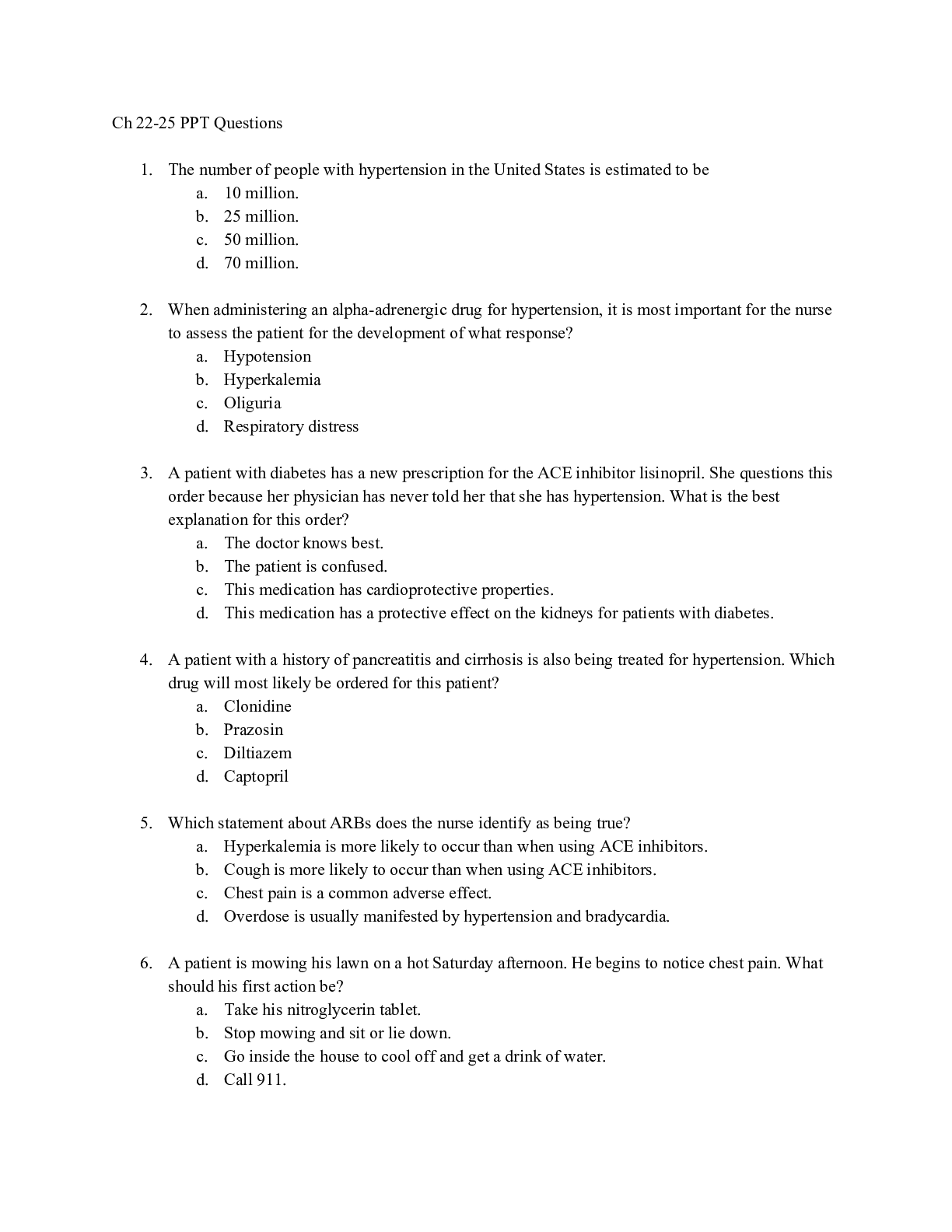
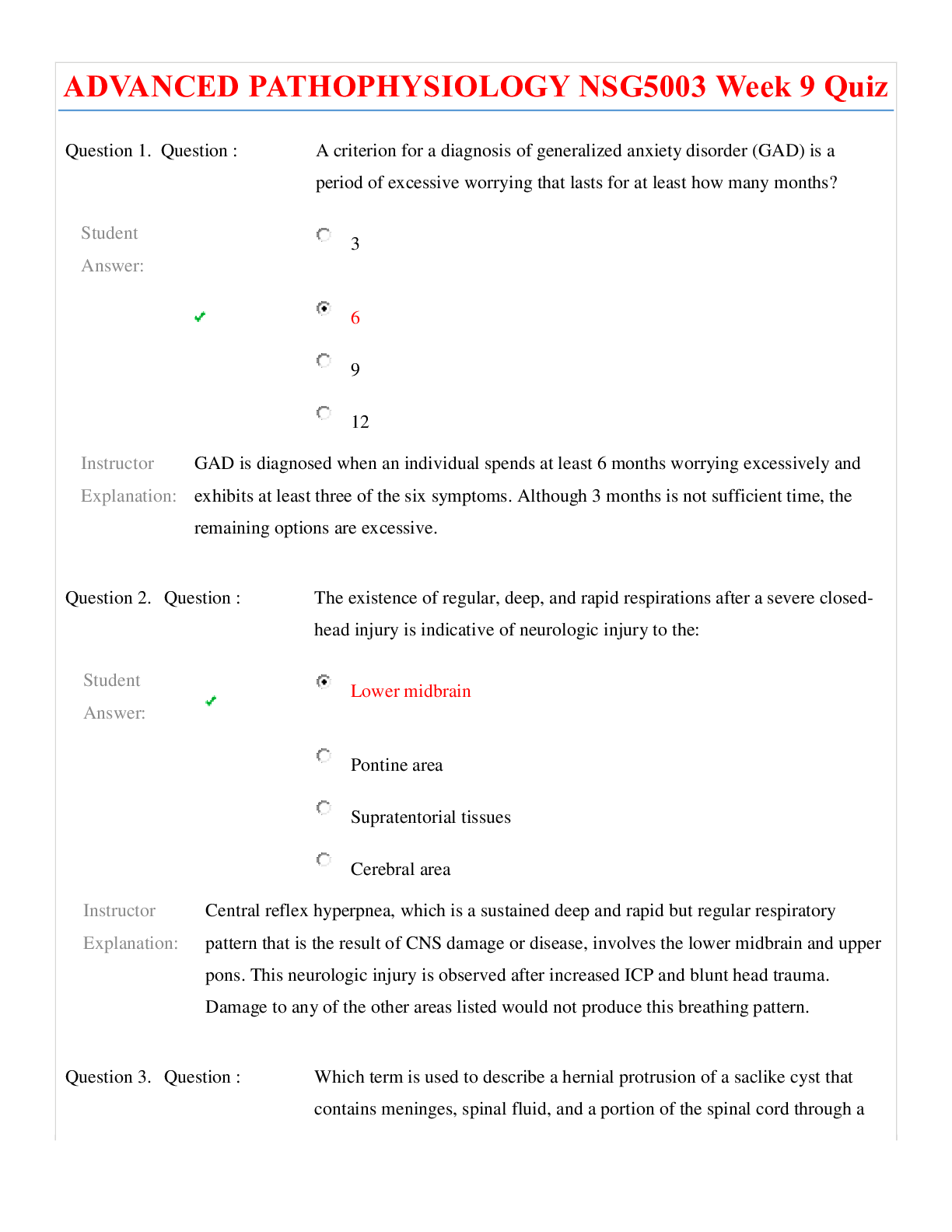
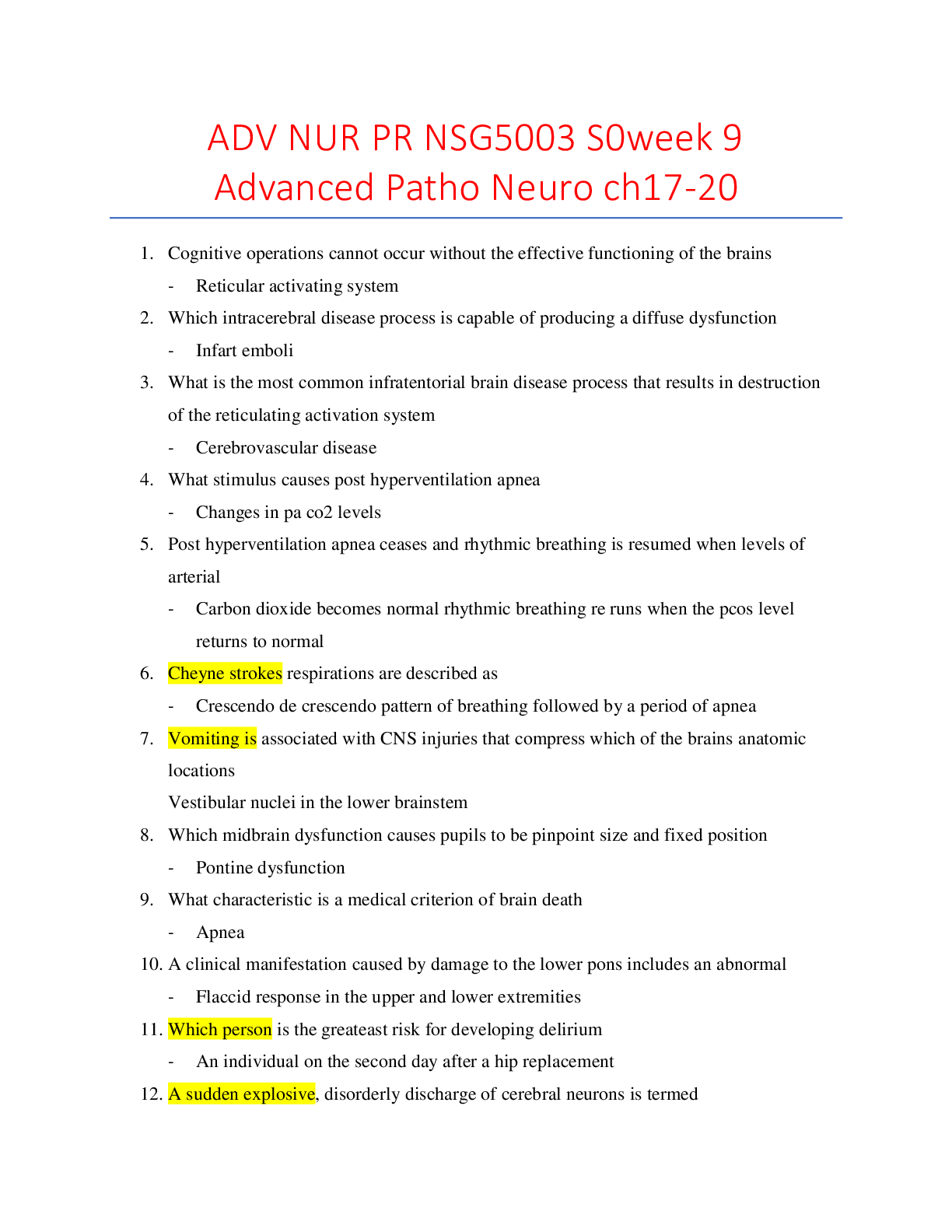
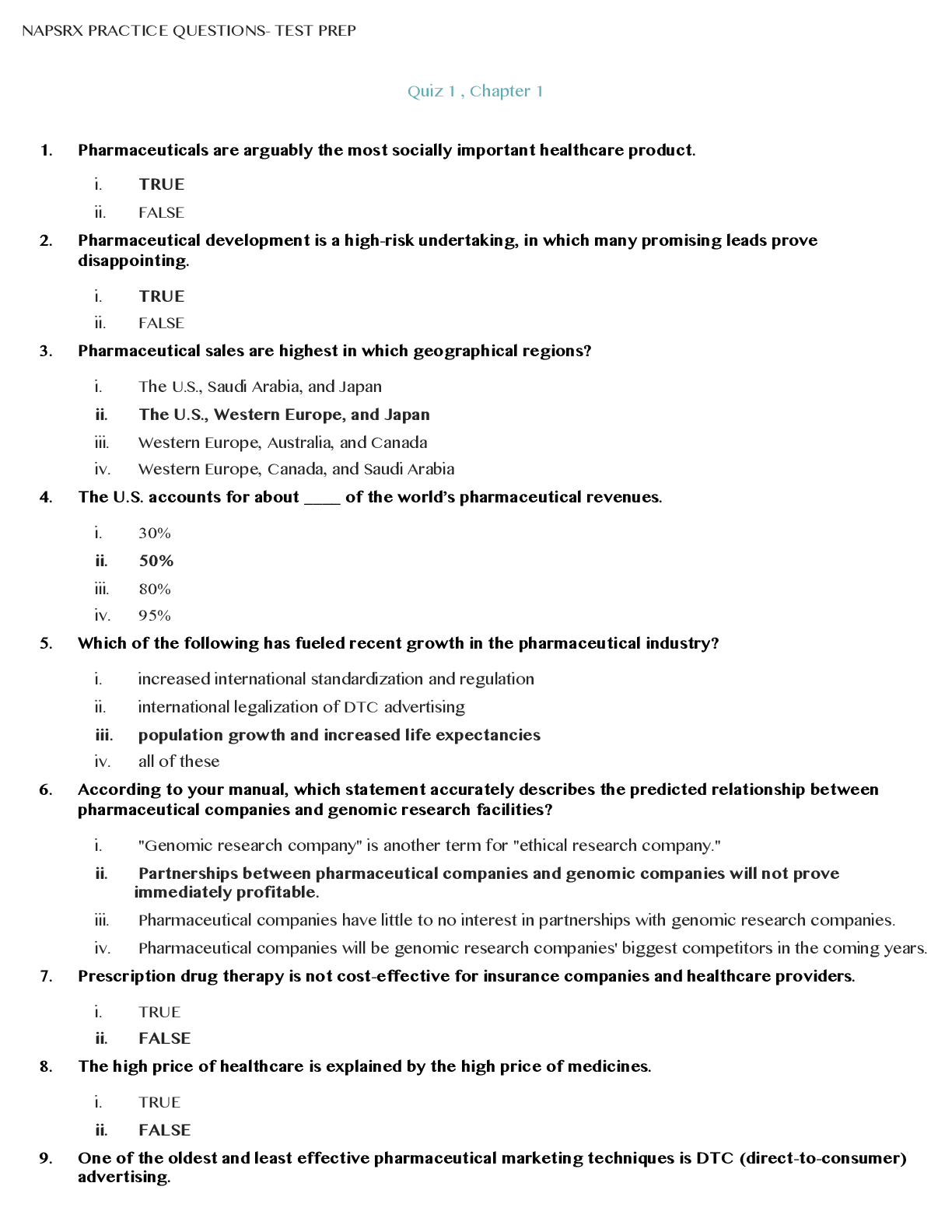
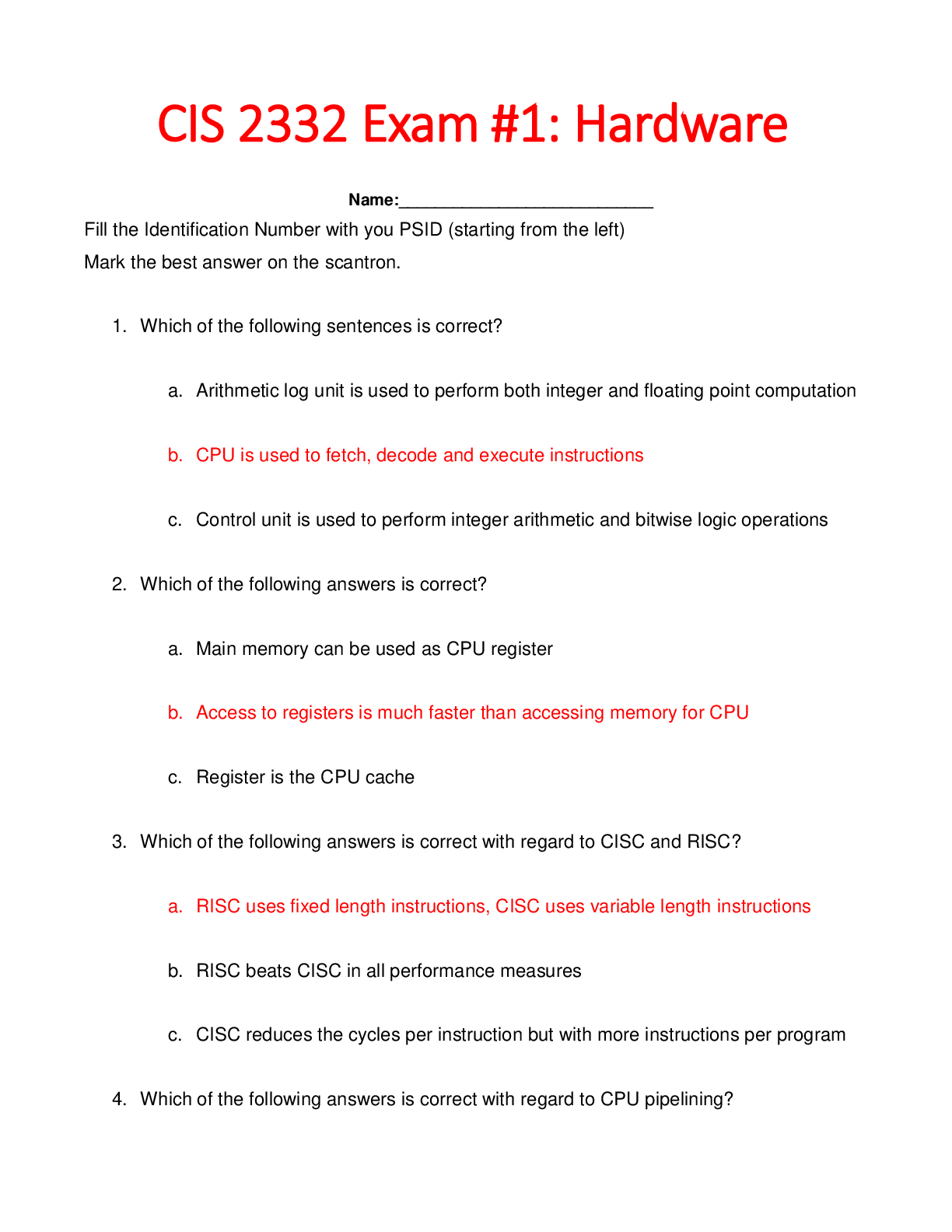
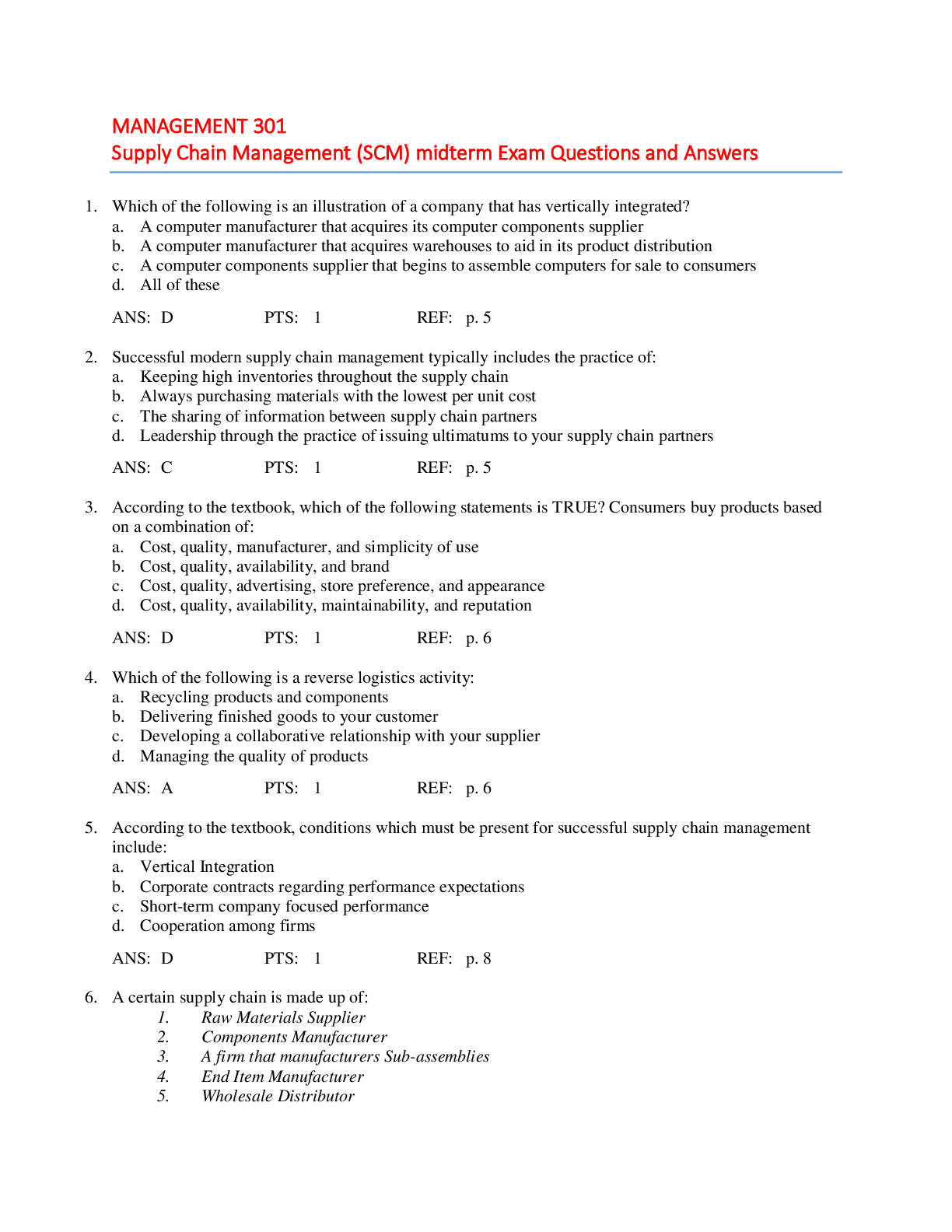
.png)


